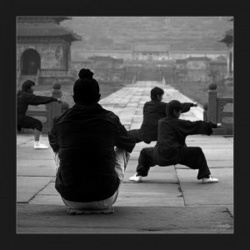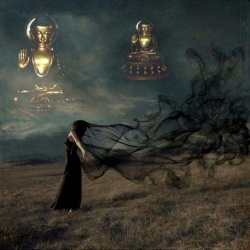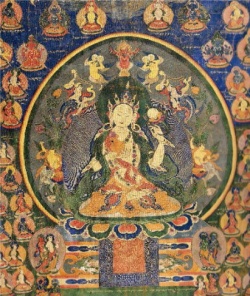Difference between revisions of "Chronology of Tibetan Buddhism"
| Line 1: | Line 1: | ||
{{DisplayImages|689|1694|2047|270|754|839|1498}} | {{DisplayImages|689|1694|2047|270|754|839|1498}} | ||
| + | |||
{| border="1" | {| border="1" | ||
| Line 28: | Line 29: | ||
| bgcolor="#ffffff" | <p> c.617–649 ce</p> | | bgcolor="#ffffff" | <p> c.617–649 ce</p> | ||
| − | | bgcolor="#ffffff" | <p> Reign of [[Songtsen Gampo]], [[king]] of the {{Wiki|Yarlung dynasty}}, the first of the three | + | | bgcolor="#ffffff" | <p> Reign of [[Songtsen Gampo]], [[king]] of the {{Wiki|Yarlung dynasty}}, the first of the three ‘[[Dharma Kings]],’ becomes first ruler over a united [[Tibet]]. He is said to have introduced [[Buddhism]] to [[Tibet]], to have married princesses from the then [[Buddhist]] countries of [[Nepal]] and [[China]], to have established the {{Wiki|capital}} at {{Wiki|Lhasa}} and to have established the [[Jokang]] and [[Ramoche]] [[temples]] there. This began the <em>Chidar</em> or ‘earlier propagation’ of [[Buddhism]] in [[Tibet]]. [[Shangshung]] may have been incorporated into the [[Tibetan]] [[Empire]] during his reign, or in that of [[Trisong Detsen]].</p> |
|- | |- | ||
| Line 34: | Line 35: | ||
| bgcolor="#ffffff" | <p> c.755–c.797/804 ce</p> | | bgcolor="#ffffff" | <p> c.755–c.797/804 ce</p> | ||
| − | | bgcolor="#ffffff" | <p> Reign of [[Trisong Detsen]], the second of the three | + | | bgcolor="#ffffff" | <p> Reign of [[Trisong Detsen]], the second of the three ‘[[Dharma Kings]]’; he is claimed to have invited [[Padmasambhava]], [[Śāntaraksita]], [[Vimalamitra]] and other [[Buddhist]] [[teachers]] to [[Tibet]], to have established the first [[Tibetan]] [[monastery]] at [[Samye]] in {{Wiki|Central}} [[Tibet]], to have become a [[disciple]] of [[Padmasambhava]], and to have decided at a {{Wiki|Council}} at [[Samye]] or {{Wiki|Lhasa}} for the [[Indian]] rather than the {{Wiki|Chinese}} version of [[Buddhism]] to be practised in [[Tibet]]</p> |
|- | |- | ||
| Line 46: | Line 47: | ||
| bgcolor="#ffffff" | <p> c.815–c.838 ce</p> | | bgcolor="#ffffff" | <p> c.815–c.838 ce</p> | ||
| − | | bgcolor="#ffffff" | <p> Reign of [[Ralpachen]] ([[Tritsuk Detsen]]), the third of the three | + | | bgcolor="#ffffff" | <p> Reign of [[Ralpachen]] ([[Tritsuk Detsen]]), the third of the three ‘Dharma Kings’.</p> |
|- | |- | ||
| Line 64: | Line 65: | ||
| bgcolor="#ffffff" | <p> Late 10th century</p> | | bgcolor="#ffffff" | <p> Late 10th century</p> | ||
| − | | bgcolor="#ffffff" | <p> Reign of [[Yeshe Ö]], [[king]] of Guge and Purang in {{Wiki|Western}} [[Tibet]]. He criticized the practices of [[Tibetan Buddhists]] of his [[time]], and patronized the translator [[Rinchen Sangpo]] and other [[Tibetan]] [[scholars]] who re-established [[contact]] with [[India]], beginning the <em>Ngadar</em> or | + | | bgcolor="#ffffff" | <p> Reign of [[Yeshe Ö]], [[king]] of Guge and Purang in {{Wiki|Western}} [[Tibet]]. He criticized the practices of [[Tibetan Buddhists]] of his [[time]], and patronized the translator [[Rinchen Sangpo]] and other [[Tibetan]] [[scholars]] who re-established [[contact]] with [[India]], beginning the <em>Ngadar</em> or ‘later propagation’ of [[Buddhism]] in [[Tibet]].</p> |
|- | |- | ||
| Line 82: | Line 83: | ||
| bgcolor="#ffffff" | <p> Eleventh century</p> | | bgcolor="#ffffff" | <p> Eleventh century</p> | ||
| − | | bgcolor="#ffffff" | <p> [[Drokmi]] (993–1077), [[Marpa]] (?1012–1093), and other [[Tibetan]] [[scholars]] visited [[India]] to acquire [[Tantric]] and other teachings and bring them to [[Tibet]]. This led to the establishment of the | + | | bgcolor="#ffffff" | <p> [[Drokmi]] (993–1077), [[Marpa]] (?1012–1093), and other [[Tibetan]] [[scholars]] visited [[India]] to acquire [[Tantric]] and other teachings and bring them to [[Tibet]]. This led to the establishment of the ‘New Tantra’ ([[Sarmapa]]) [[traditions]] in [[Tibet]].</p> |
|- | |- | ||
| Line 94: | Line 95: | ||
| bgcolor="#ffffff" | <p> 12th century</p> | | bgcolor="#ffffff" | <p> 12th century</p> | ||
| − | | bgcolor="#ffffff" | <p> [[Marpa]] | + | | bgcolor="#ffffff" | <p> [[Marpa]]’s student [[Milarepa]] (1040–1123) established the [[tradition]] of [[Nāropa]] in [[Tibet]]; the students of his [[disciple]] [[Gampopa]] (1079–1153) founded the [[monastic]] centres ([[Densa Til]] 1158; [[Drigung]] 1179; [[Ralung]] 1180; [[Tsurpu]] 1189) from which the [[Kagyüpa]] [[traditions]] developed.</p> |
|- | |- | ||
| Line 118: | Line 119: | ||
| bgcolor="#ffffff" | <p> 1247</p> | | bgcolor="#ffffff" | <p> 1247</p> | ||
| − | | bgcolor="#ffffff" | <p> [[Sakya Pandita]] met with the Mongol ruler [[Godan]], negotiating [[Tibetan]] acceptance of Mongol rule as a so-called | + | | bgcolor="#ffffff" | <p> [[Sakya Pandita]] met with the Mongol ruler [[Godan]], negotiating [[Tibetan]] acceptance of Mongol rule as a so-called ‘priest–patron’ relationship.</p> |
|- | |- | ||
| Line 124: | Line 125: | ||
| bgcolor="#ffffff" | <p> 1276</p> | | bgcolor="#ffffff" | <p> 1276</p> | ||
| − | | bgcolor="#ffffff" | <p> [[Sakya]] | + | | bgcolor="#ffffff" | <p> [[Sakya]] Pahndita’s nephew [[Pakpa]] became ruler of [[Tibet]] under the Mongol overlordship.</p> |
|- | |- | ||
| Line 136: | Line 137: | ||
| bgcolor="#ffffff" | <p> 14th century</p> | | bgcolor="#ffffff" | <p> 14th century</p> | ||
| − | | bgcolor="#ffffff" | <p> [[Longchen Rabjampa]] (1308–1363) ordered the [[Nyingma]] teachings into a consistent system, bringing them into [[relation]] with the | + | | bgcolor="#ffffff" | <p> [[Longchen Rabjampa]] (1308–1363) ordered the [[Nyingma]] teachings into a consistent system, bringing them into [[relation]] with the ‘New Tantra’ [[traditions]].</p> |
|- | |- | ||
| Line 148: | Line 149: | ||
| bgcolor="#ffffff" | <p> Early 15th century</p> | | bgcolor="#ffffff" | <p> Early 15th century</p> | ||
| − | | bgcolor="#ffffff" | <p> [[Tsongkapa]] (1357–1419), created a new synthesis based on [[Kadampa]], [[Kagyüpa]] and [[Sakyapa]] teachings. His [[monastery]] of [[Ganden]] (founded 1409) near {{Wiki|Lhasa}} became the centre of this | + | | bgcolor="#ffffff" | <p> [[Tsongkapa]] (1357–1419), created a new synthesis based on [[Kadampa]], [[Kagyüpa]] and [[Sakyapa]] teachings. His [[monastery]] of [[Ganden]] (founded 1409) near {{Wiki|Lhasa}} became the centre of this ‘[[New Kadampa]]’ or [[Gelukpa]] [[tradition]]. [[Tsongkapa]]’s [[disciples]] founded other great [[monastic]] [[teaching]] centres, including [[Drepung]] (1416), [[Sera]] (1419) and [[Tashilhunpo]] (1447). [[Gedün Drup]] (1391–1474), the founder of [[Tashilhunpo]], was to become the first of the [[reincarnate lamas]] series now known as the [[Dalai Lama]]s.</p> |
|- | |- | ||
| Line 154: | Line 155: | ||
| bgcolor="#ffffff" | <p> 1577</p> | | bgcolor="#ffffff" | <p> 1577</p> | ||
| − | | bgcolor="#ffffff" | <p> [[Sonam Gyatso]] (1543–1588), the second [[rebirth]] of Gedün Drup, established a | + | | bgcolor="#ffffff" | <p> [[Sonam Gyatso]] (1543–1588), the second [[rebirth]] of Gedün Drup, established a ‘priest–patron’ relationship with the Tumed Mongol {{Wiki|prince}} {{Wiki|Altan Khan}}, who gave him the title ‘[[Dalai Lama]]’.</p> |
|- | |- | ||
| Line 160: | Line 161: | ||
| bgcolor="#ffffff" | <p> 1590s</p> | | bgcolor="#ffffff" | <p> 1590s</p> | ||
| − | | bgcolor="#ffffff" | <p> Following the [[death]] of [[Sonam Gyatso]], the grandson of Altan | + | | bgcolor="#ffffff" | <p> Following the [[death]] of [[Sonam Gyatso]], the grandson of Altan Khan’s successor was [[recognized]] as his [[rebirth]], thus becoming the [[4th Dalai Lama]] (1589–1617).</p> |
|- | |- | ||
| Line 190: | Line 191: | ||
| bgcolor="#ffffff" | <p> 1788–1792</p> | | bgcolor="#ffffff" | <p> 1788–1792</p> | ||
| − | | bgcolor="#ffffff" | <p> A [[war]] with the {{Wiki|Gurkha}} regime in [[Nepal]] led to a further {{Wiki|Manchu}} intervention and the Qianlong | + | | bgcolor="#ffffff" | <p> A [[war]] with the {{Wiki|Gurkha}} regime in [[Nepal]] led to a further {{Wiki|Manchu}} intervention and the Qianlong Emperor’s imposition of control over the [[recognition]] of {{Wiki|senior}} [[reincarnations]], which continued to the early 19th century.</p> |
|- | |- | ||
| Line 208: | Line 209: | ||
| bgcolor="#ffffff" | <p> 1910–11</p> | | bgcolor="#ffffff" | <p> 1910–11</p> | ||
| − | | bgcolor="#ffffff" | <p> Attempts by the {{Wiki|Chinese}} rulers of {{Wiki|Qinghai}} to impose control over Eastern [[Tibet]] culminated in an invasion of {{Wiki|Central}} [[Tibet]] and the flight to [[India]] of the [[13th Dalai Lama]] (Tupten Gyatso, 1876–1933). He returned after the fall of the {{Wiki|Manchu}} regime in 1911. The Simla convention of 1914 [[recognized]] the autonomy of | + | | bgcolor="#ffffff" | <p> Attempts by the {{Wiki|Chinese}} rulers of {{Wiki|Qinghai}} to impose control over Eastern [[Tibet]] culminated in an invasion of {{Wiki|Central}} [[Tibet]] and the flight to [[India]] of the [[13th Dalai Lama]] (Tupten Gyatso, 1876–1933). He returned after the fall of the {{Wiki|Manchu}} regime in 1911. The Simla convention of 1914 [[recognized]] the autonomy of ‘Outer Tibet’ (i.e. the area under the {{Wiki|Lhasa}} Government) under {{Wiki|Chinese}} ‘suzerainty’. It was not signed by [[China]], but the {{Wiki|Lhasa}} government was <em>de facto</em> independent until 1949. Fighting continued intermittently during the 1920s and 1930s in {{Wiki|East}} [[Tibet]].</p> |
|- | |- | ||
| Line 220: | Line 221: | ||
| bgcolor="#ffffff" | <p> 1933 onwards</p> | | bgcolor="#ffffff" | <p> 1933 onwards</p> | ||
| − | | bgcolor="#ffffff" | <p> The [[Dalai]] | + | | bgcolor="#ffffff" | <p> The [[Dalai]] Lama’s [[death]] and the removal of the regent [[Reting Rinpoche]] brought the {{Wiki|movement}} to modernization to an end, with conservative [[monastic]] rule re-established under the regent [[Taktra Rinpoche]].</p> |
|- | |- | ||
| Line 226: | Line 227: | ||
| bgcolor="#ffffff" | <p> 1949–51</p> | | bgcolor="#ffffff" | <p> 1949–51</p> | ||
| − | | bgcolor="#ffffff" | <p> Following the {{Wiki|Communist}} takeover in [[China]], the [[14th Dalai Lama]] (b.1935) took over as head of the [[Tibetan]] Government in 1950. The {{Wiki|Chinese}} government asserted direct control over | + | | bgcolor="#ffffff" | <p> Following the {{Wiki|Communist}} takeover in [[China]], the [[14th Dalai Lama]] (b.1935) took over as head of the [[Tibetan]] Government in 1950. The {{Wiki|Chinese}} government asserted direct control over ‘Inner Tibet’ (the [[Tibetan]] areas of {{Wiki|Qinghai}}, [[wikipedia:Gansu|Gansu]], {{Wiki|Sichuan}} and Yunnan), now renamed the ‘Tibet Autonomous Region,’ and imposed the ‘17 Point Agreement’ on the {{Wiki|Lhasa}} Government.</p> |
|- | |- | ||
| Line 250: | Line 251: | ||
| bgcolor="#ffffff" | <p> 1980 onwards</p> | | bgcolor="#ffffff" | <p> 1980 onwards</p> | ||
| − | | bgcolor="#ffffff" | <p> A {{Wiki|degree}} of liberalization and reform following Party Secretary Hu Yaobang | + | | bgcolor="#ffffff" | <p> A {{Wiki|degree}} of liberalization and reform following Party Secretary {{Wiki|Hu Yaobang}}’s visit to [[Tibet]], but more repressive policies were gradually reintroduced. Further demonstrations against {{Wiki|Chinese}} rule have taken place periodically from 1987 onwards, and been forcibly suppressed.</p> |
|} | |} | ||
Revision as of 04:14, 18 January 2014
c.1900 bce |
Legendary visit of the Bonpo founding figure, Tönpa Shenrab, to Tibet. |
c.400 bce |
Approximate date of the parinirvāṇa (death) of the historical Buddha Śākyamuni. |
c.250 bce |
Buddhism receives state patronage by the Mauryan emperor Aśoka and is established throughout much of present-day India, Pakistan and Bangladesh. |
5th century ce |
Approximate date of semi-legendary king Lhato Tori of the Yarlung dynasty in whose time Buddhist scriptures, including the Kārandavyūha Sūtra, are said to have first reached Tibet. |
c.617–649 ce |
Reign of Songtsen Gampo, king of the Yarlung dynasty, the first of the three ‘Dharma Kings,’ becomes first ruler over a united Tibet. He is said to have introduced Buddhism to Tibet, to have married princesses from the then Buddhist countries of Nepal and China, to have established the capital at Lhasa and to have established the Jokang and Ramoche temples there. This began the Chidar or ‘earlier propagation’ of Buddhism in Tibet. Shangshung may have been incorporated into the Tibetan Empire during his reign, or in that of Trisong Detsen. |
c.755–c.797/804 ce |
Reign of Trisong Detsen, the second of the three ‘Dharma Kings’; he is claimed to have invited Padmasambhava, Śāntaraksita, Vimalamitra and other Buddhist teachers to Tibet, to have established the first Tibetan monastery at Samye in Central Tibet, to have become a disciple of Padmasambhava, and to have decided at a Council at Samye or Lhasa for the Indian rather than the Chinese version of Buddhism to be practised in Tibet |
c.775–779 ce |
Approximate date for the establishment of Samye, first Tibetan monastery, by Padmasambhava and Śāntaraksita under the patronage of Trisong Detsen. |
c.815–c.838 ce |
Reign of Ralpachen (Tritsuk Detsen), the third of the three ‘Dharma Kings’. |
c.838–c.841 ce |
Reign of Langdarma. Buddhist tradition regards him as a supporter of the Bon religion and persecutor of Buddhism. He is said to have been killed by the monk Lhalung Pelgi Dorjé, bringing the Tibetan Empire to an end. |
Late 9th and early 10th centuries |
Contact with Buddhism in India and Nepal was largely lost during this period, and Buddhism continued primarily as a tradition of hereditary village lamas and Tantric ritualists. |
Late 10th century |
Reign of Yeshe Ö, king of Guge and Purang in Western Tibet. He criticized the practices of Tibetan Buddhists of his time, and patronized the translator Rinchen Sangpo and other Tibetan scholars who re-established contact with India, beginning the Ngadar or ‘later propagation’ of Buddhism in Tibet. |
c.1037–c.1057 |
Reign of Changchub Ö, king of Guge and Purang. He further patronized Buddhist scholarship, and invited the Indian scholar Atiśa (Dīpaṁkaraśrījñāna) to Tibet. |
1042 |
Atiśa came to Tibet and founded the monastery of Nyetang near Lhasa with the support of his wealthy lay follower Dromtön. This was the origin of the Kadampa tradition of Tibetan Buddhism. |
Eleventh century |
Drokmi (993–1077), Marpa (?1012–1093), and other Tibetan scholars visited India to acquire Tantric and other teachings and bring them to Tibet. This led to the establishment of the ‘New Tantra’ (Sarmapa) traditions in Tibet. |
1073 |
Foundation of the monastery of Sakya in West-Central Tibet by Kön Konchok Gyelpo of the hereditary lama family of Kön. His successors acquired the Tantric practices of Virūpa from Drokmi; these became the basis of the Sakyapa tradition of Tibetan Buddhism. |
12th century |
Marpa’s student Milarepa (1040–1123) established the tradition of Nāropa in Tibet; the students of his disciple Gampopa (1079–1153) founded the monastic centres (Densa Til 1158; Drigung 1179; Ralung 1180; Tsurpu 1189) from which the Kagyüpa traditions developed. |
11th–12th centuries |
Reconstruction of the surviving lineages of hereditary lamas with the aid of terma revelations, leading to the Nyingmapa and (Yungdrung) BÖN traditions. |
13th century |
Development of the system of recognizing reincarnate lamas, initially in the Kagyüpa traditions. |
13th–early 14th century |
Sakya Pandita (1182–1251), Putön Rinchen Drubpa (1290–1364) and others re-established the monastic and scholarly aspects of Indian Buddhism in Tibet. |
1247 |
Sakya Pandita met with the Mongol ruler Godan, negotiating Tibetan acceptance of Mongol rule as a so-called ‘priest–patron’ relationship. |
1276 |
Sakya Pahndita’s nephew Pakpa became ruler of Tibet under the Mongol overlordship. |
1354 |
Collapse of Mongol rule over Tibet; Changchub Gyantsen, a Tibetan administrator under the Mongols and supporter of the Kagyüpas, becomes ruler of Central Tibet, with his capital at Neudong in East-Central Tibet. |
14th century |
Longchen Rabjampa (1308–1363) ordered the Nyingma teachings into a consistent system, bringing them into relation with the ‘New Tantra’ traditions. |
1405 |
Founding of Menri Monastery by the great Bonpo scholar Nyame Sherab Gyaltsen (1356–1415). |
Early 15th century |
Tsongkapa (1357–1419), created a new synthesis based on Kadampa, Kagyüpa and Sakyapa teachings. His monastery of Ganden (founded 1409) near Lhasa became the centre of this ‘New Kadampa’ or Gelukpa tradition. Tsongkapa’s disciples founded other great monastic teaching centres, including Drepung (1416), Sera (1419) and Tashilhunpo (1447). Gedün Drup (1391–1474), the founder of Tashilhunpo, was to become the first of the reincarnate lamas series now known as the Dalai Lamas. |
1577 |
Sonam Gyatso (1543–1588), the second rebirth of Gedün Drup, established a ‘priest–patron’ relationship with the Tumed Mongol prince Altan Khan, who gave him the title ‘Dalai Lama’. |
1590s |
Following the death of Sonam Gyatso, the grandson of Altan Khan’s successor was recognized as his rebirth, thus becoming the 4th Dalai Lama (1589–1617). |
1590s |
Following the death of the 4th Gyalwang Drukpa, Pema Karpo, head of the Drukpa Kagyüpa, there was a conflict between supporters of two candidates, leading to one candidate, Shabdrung Ngawang Namgyal (1594–1651), fleeing to Bhutan in 1616 and becoming the head of a new Bhutanese state. |
15th – early 17th centuries |
Ongoing political conflicts in Central Tibet, brought to an end by the establishment of Gelugpa rule over Central Tibet, as well as large parts of Eastern and Western Tibet, by Gushri Khan, a Khoshut Mongol chieftain and supporter of the 5th Dalai Lama, Ngawang Lobsang Gyatso (1617–1682). |
1697 |
The death of the 5th Dalai Lama, which had been concealed by the Regent, Desi Sangye Gyatso, was revealed, and the 6th Dalai Lama enthroned. |
1706 |
The 6th Dalai Lama was deposed by the Khoshut Mongol chieftain Lhasang Khan, with the encouragement of the Manchu ruler of China. Lhasang Khan was subsequently killed by a force led by the Dzungar Mongol chieftain Tsewang Rabten, leading to further political conflict. The Manchu rulers of China intervened in Tibet, removing the Dzungars and recognizing one of two competing candidates as 7th Dalai Lama. Effective power was re-established by the Tibetan noble Pholané in 1728, but a Chinese garrison and two Manchu officials (the Ambans) remained at Lhasa until 1911. |
1788–1792 |
A war with the Gurkha regime in Nepal led to a further Manchu intervention and the Qianlong Emperor’s imposition of control over the recognition of senior reincarnations, which continued to the early 19th century. |
19th century |
During the nineteenth century, the 9th to 12th Dalai Lamas all died young, and effective power in Central Tibet was exercised by a succession of regents, mostly selected from four major Lhasa monasteries. |
1903–04 |
A British army, the Younghusband Expedition, invaded Central Tibet, imposing a trade agreement on the Lhasa Government. |
1910–11 |
Attempts by the Chinese rulers of Qinghai to impose control over Eastern Tibet culminated in an invasion of Central Tibet and the flight to India of the 13th Dalai Lama (Tupten Gyatso, 1876–1933). He returned after the fall of the Manchu regime in 1911. The Simla convention of 1914 recognized the autonomy of ‘Outer Tibet’ (i.e. the area under the Lhasa Government) under Chinese ‘suzerainty’. It was not signed by China, but the Lhasa government was de facto independent until 1949. Fighting continued intermittently during the 1920s and 1930s in East Tibet. |
1920s |
The Lhasa Government, under the 13th Dalai Lama, attempted to modernize and centralize the Tibetan state. This led to conflict with the Panchen Lama, who fled to China. |
1933 onwards |
The Dalai Lama’s death and the removal of the regent Reting Rinpoche brought the movement to modernization to an end, with conservative monastic rule re-established under the regent Taktra Rinpoche. |
1949–51 |
Following the Communist takeover in China, the 14th Dalai Lama (b.1935) took over as head of the Tibetan Government in 1950. The Chinese government asserted direct control over ‘Inner Tibet’ (the Tibetan areas of Qinghai, Gansu, Sichuan and Yunnan), now renamed the ‘Tibet Autonomous Region,’ and imposed the ‘17 Point Agreement’ on the Lhasa Government. |
1956–59 |
Increasing conflicts resulting from Chinese Government policy led to an unsuccessful revolt against Chinese rule and the flight of numerous refugees, including the 14th Dalai Lama, to India and Nepal. |
1959–62 |
|
1966–76 |
Cultural Revolution led to further widespread suppression of Buddhist practice and destruction of Buddhist institutions throughout Tibet. |
1980 onwards |
A degree of liberalization and reform following Party Secretary Hu Yaobang’s visit to Tibet, but more repressive policies were gradually reintroduced. Further demonstrations against Chinese rule have taken place periodically from 1987 onwards, and been forcibly suppressed. |






